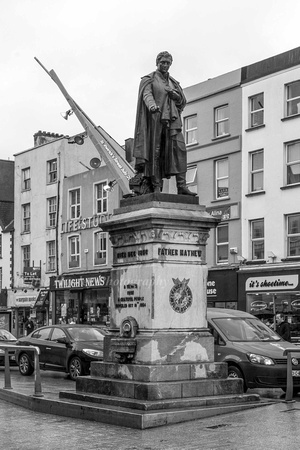The movement with which his name is associated began on 10 April 1838 with the establishment of the "
Cork Total Abstinence Society" which relied on one enduring act of will to keep a person sober for life. It was called simply
The Pledge. It could be made by anybody, either with or without an
alcohol problem.
Father Mathew did not believe in gradual approaches or temporary commitments. He advocated a promise that meant complete commitment. It did not bind like the vows of marriage, but the principle of permanent commitment was the same. Fr Mathew believed that as long as the act of will continued, it could overcome all difficulties.
One simple commitment, encased in the words of the Total Abstinence Pledge, supposedly did the trick. The surroundings did not make much difference. One could take the pledge as a single individual or as one of a waiting line coming up in a parish, mobilised and brimming with enthusiasm for the occasion. However, Father Mathew arrived at this conclusion only after much prayer for guidance and after urging by others who proposed total abstinence over moderation. There is also unconfirmed knowledge that he was a heavy drinker before he saw a vision of a strange bird-man who told him to change his ways.
I promise to abstain from all intoxicating drinks except used medicinally and by order of a medical man and to discountenance the cause and practice of intemperance
In less than nine months no fewer than 150,000 names were enrolled as taking the Pledge. It rapidly spread to
Limerick and elsewhere, and some idea of its popularity may be formed from the fact that at
Nenagh 20,000 persons are said to have taken the pledge in one day, 100,000 at
Galway in two days, and 70,000 in Dublin in five days. At its height, just before the
Great Famine of 1845-49, his movement enrolled some 3 million people, or more than half of the adult population of Ireland. In 1844 he visited
Liverpool,
Manchester and
London with almost equal success.
His work had a remarkable impact on the condition of the people in Ireland:
“The number of homicides, which was 247 in 1838, was only 105 in 1841. There were 91 cases of ‘firing at the person’ reported in 1837, and but 66 in 1841. The ‘assaults on police’ were 91 in 1837, and but 58 in 1841. Incendiary fires, which were as many as 459 in 1838, were 390 in 1841. Robberies, thus specially reported, diminished from 725 in 1837, to 257 in 1841. The decrease in cases of ‘robbery of arms’ was most significant; from being 246 in 1837, they were but 111 in 1841. The offence of ‘appearing in arms’ showed a favourable diminution, falling from 110 in 1837, to 66 in 1841. The effect of sobriety on ‘faction fights’ was equally remarkable. There were 20 of such cases in 1839, and 8 in 1841. The dangerous offence of ‘rescuing prisoners,’ which was represented by 34 in 1837, had no return in 1841!”
[3]The number committed to jail fell from 12,049 in 1839 to 7,101 by 1845. Sentences of death fell from 66 in 1839 to 14 in 1846, and transportations fell from 916 to 504 over the same period.
However, his campaign did have the unforeseen consequence of an increase in the consumption of
diethyl ether, a chemical much more pharmacologically dangerous and chemically unstable than alcohol, by those seeking to become intoxicated without breaking the letter of their pledge. It also caused many breweries and distilleries to close.


